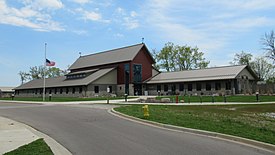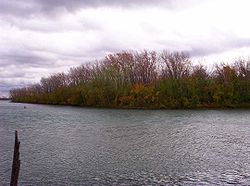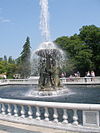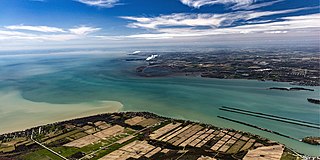
The Detroit River flows west and south for 24 nautical miles from Lake St. Clair to Lake Erie as a strait in the Great Lakes system. The river divides the metropolitan areas of Detroit, Michigan, and Windsor, Ontario—an area collectively referred to as Detroit–Windsor—and forms part of the border between Canada and the United States. The Ambassador Bridge, the Detroit–Windsor Tunnel, and the Michigan Central Railway Tunnel connect the cities.

The River Raisin is a river in southeastern Michigan, United States, that flows through glacial sediments into Lake Erie. The area today is an agricultural and industrial center of Michigan. The river flows for almost 139 miles (224 km), draining an area of 1,072 square miles (2,780 km2) in the Michigan counties of Lenawee, Washtenaw, Jackson, Hillsdale, and Monroe County, where its mouth at Lake Erie is located. French settlers named it as La Rivière aux Raisins because of the wild grapes growing along its banks, the French word for grape being raisin. The French term for "raisin" is raisin sec.
Montezuma National Wildlife Refuge is a wildlife preserve operated by the United States Fish and Wildlife Service, encompassing part of the Montezuma Swamp at the north end of Cayuga Lake. The 10,004-acre (40.48 km2) preserve is composed of swamps, pools and channels and is a stopping point for migratory birds.
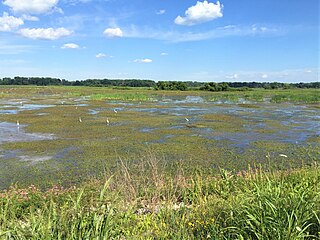
The Shiawassee National Wildlife Refuge is a 9,870.35 acres (39.9439 km2) National Wildlife Refuge in Saginaw County managed by the United States Fish and Wildlife Service. It is located in the central portion of the lower peninsula of the U.S. state of Michigan, approximately 25 miles (40 km) south of the Saginaw Bay in Lake Huron and five miles (8 km) south of the city of Saginaw in the county's Spaulding and James townships. It was established in 1953 to provide habitat for migratory waterfowl.

Missisquoi National Wildlife Refuge is a National Wildlife Refuge located in the eastern shore of Lake Champlain in the U.S. state of Vermont. The refuge is in Franklin County in the northwest corner of the state near the International Boundary with Canada. It is the only National Wildlife Refuge located entirely in Vermont, and is administered by the United States Fish and Wildlife Service.
The protected areas of Michigan come in an array of different types and levels of protection. Michigan has five units of the National Park Service system. There are 14 federal wilderness areas; the majority of these are also tribal-designated wildernesses. It has one of the largest state forest systems as well having four national forests. The state maintains a large state park system and there are also regional parks, and county, township and city parks. Still other parks on land and in the Great Lakes are maintained by other governmental bodies. Private protected areas also exist in the state, mainly lands owned by land conservancies.

William C. Sterling State Park is a public recreation area located in Frenchtown Charter Township with a small portion lying within the city limits of Monroe, Michigan. It is the only Michigan state park located on Lake Erie. The park encompasses 1,300 acres (530 ha) of mostly man-made lagoons and beachfront near the mouth of Sandy Creek. The main attractions at the park include a 256-site campground, beach area, boat launch, and shore fishing lagoons. There are over seven miles (11 km) of biking and hiking trails within the park.

Detroit Island is an island in Lake Michigan in the southern part of the town of Washington in Door County, Wisconsin, United States. The island has a land area of 2.578 km², out of which 27.6% is open to the public. The northern end of the island borders the waters of Detroit Harbor.

Pointe Mouillee State Game Area is a state game area in the U.S. state of Michigan. It encompasses 7,483 acres (30.3 km2) of hunting, recreational, and protected wildlife and wetland areas at the mouth of the Huron River at Lake Erie, as well as smaller outlying areas within the Detroit River. Pointe Mouillee State Game Area was established in 1945 and is administered by the Michigan Department of Natural Resources.

Grassy Island is a small, uninhabited 72-acre (29 ha) American island in the Detroit River. It is located just north of Grosse Ile and west of Fighting Island, about 600 feet (180 m) west of the Canada–United States border. The island is part of the city of Wyandotte, in Wayne County. The island is part of the Detroit River International Wildlife Refuge. Grassy Island should not be confused with Grass Island, which is an island of Ontario on the exact opposite side of the Detroit River.

Mamajuda Island, sometimes identified as Mama Juda Island, was an American island in the Detroit River. It is located just east of the northern tip of Grosse Ile and about 500 feet west of the Canada–United States border. The island is part of Grosse Ile Township in Wayne County, Michigan. It is the smallest of all charted islands in the Detroit River.
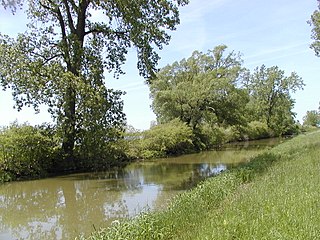
Cedar Point National Wildlife Refuge was established in 1964 when the owners of the Cedar Point Shooting Club donated the land to the United States Fish and Wildlife Service. The refuge is now about 2,630 acres (10.6 km2) of marsh that is divided into three pools. The largest one is almost 2,000 acres (8.1 km2), it is the largest contiguous marsh in Ohio’s Lake Erie marshes.

The North Maumee Bay Archeological District is a historic district containing archeological sites located in the southeasternmost corner of Erie Township in Monroe County, Michigan. It was added to the National Register of Historic Places on December 5, 1980.
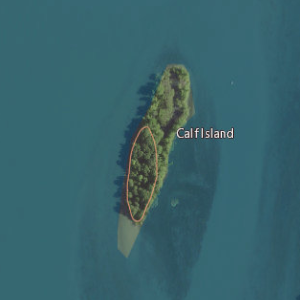
Calf Island is an island in the Detroit River, in Michigan. It has a surface elevation of 571 feet. It is located in the Trenton Channel about 1,000 feet west of the southern tip of Grosse Ile and Swan Island, and Hamburg Island is just to the northwest. The 7-acre island is administered locally by Grosse Ile Township.

The Summer Lake Wildlife Area is a 29.6-square-mile (77 km2) wildlife refuge located on the northwestern edge of the Great Basin drainage in south-central Oregon. It is administered by the Oregon Department of Fish and Wildlife. The refuge is an important stop for waterfowl traveling along the Pacific Flyway during their spring and fall migrations. The Summer Lake Wildlife Area also provides habitat for shorebirds and other bird species as well as wide variety of mammals and several fish species. The Ana River supplies the water for the refuge wetlands.
Humbug Marsh, a 1.88 square kilometres (0.73 sq mi) wetland in southeastern Wayne County, Michigan, is a constituent element of the Detroit River International Wildlife Refuge. It is listed as a Ramsar wetland of international importance.

Stony Island is an island in the Detroit River, in southeast Michigan. It has been used for hunting and fishing as long as humans have inhabited the region; from the mid-19th century to the mid-20th century, it was the site of a small settlement and served as a central location for the construction of the Livingstone Channel, as well as various civil engineering projects involving the Detroit River. By the 1990s, it had become completely uninhabited; it is now open to the public and administered by the Michigan Department of Natural Resources.
